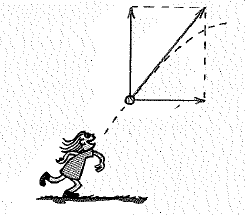
Concept explainers
a. How far below an initial straight-line path will a projectile fall in one second?
b. Does your answer depend on the angle of launch or on the initial speed of the projectile? Defend your answer.

(a)
The distance below an initial straight-line path travelled by projectile while falling off.
Answer to Problem 10A
The distance below an initial straight-line path travelled by projectile while falling off is
Explanation of Solution
Given:
The time period is
Formula used:
The expression for equation of motion under constant acceleration is,
Here,
Calculation:
Consider the acceleration due to gravity as
The distance below an initial straight-line path will a projectile fall in one second is,
Conclusion:
Thus, the distance below an initial straight-line path travelled by projectile while falling off in one second is
(b)
To identify:Whether the distance travelled obtained in part (a) depends on the angle of launch or on the initial speed of the projectile.
Answer to Problem 10A
The distance neither depend on the angle of launch nor on the initial speed of the projectile.
Explanation of Solution
Given:
The time period is
Formula used:
The expression for equation of motion under constant acceleration is,
Here,
Calculation:
The expression for vertical distance below the line is,
Here,
The equation of vertical distance is not relative to the angle of launch or the initial speed of the projectile. It is relative to the acceleration due to gravity and the time.
Conclusion:
Thus, the distance doesn’t depend on the angle of launch or on the initial speed of the projectile.
Chapter 5 Solutions
EP CONCEPTUAL PHYSICS-ITEXT ACCESS
Additional Science Textbook Solutions
Laboratory Experiments in Microbiology (12th Edition) (What's New in Microbiology)
Genetic Analysis: An Integrated Approach (3rd Edition)
Human Physiology: An Integrated Approach (8th Edition)
Campbell Biology (11th Edition)
Applications and Investigations in Earth Science (9th Edition)
Chemistry: An Introduction to General, Organic, and Biological Chemistry (13th Edition)
- 4. In the figure below what is the value of the angle 0? A 30arrow_forwardPLEASE help with the experimental setup for this theory because i am so confused.arrow_forwardPart 2 - Geometry and Trigonometry 1. Line B touches the circle at a single point. Line A extends radially through the center of the circle. A B (a) Which line is tangential to the circumference of the circle? (b) What is the angle between lines A and B. 2. In the figure below what is the angle C? 30 45 3. In the figure below what is the value of the angle 0? 30° 4. In the figure below what is the value of the angle 0? A 30°arrow_forward
- Details solution No chatgpt plsarrow_forwardPlease solve and answer the problem correctly please.Thank you!!arrow_forwardWill you please walk me through the calculations in more detail for solving this problem? I am a bit rusty on calculus and confused about the specific steps of the derivation: https://www.bartleby.com/solution-answer/chapter-3-problem-15e-modern-physics-2nd-edition/9780805303087/7cf8c31d-9476-46d5-a5a9-b897b16fe6fcarrow_forward
- please help with the abstract. Abstract - This document outlines the format of the lab report and describes the Excel assignment. The abstract should be a short paragraph that very briefly includes the experiment objective, method, result and conclusion. After skimming the abstract, the reader should be able to decide whether they want to keep reading your work. Both the format of the report and the error analysis are to be followed. Note that abstract is not just the introduction and conclusion combined, but rather the whole experiment in short including the results. I have attacted the theory.arrow_forwardUsing the Experimental Acceleration due to Gravity values from each data table, Data Tables 1, 2, and 3; determine the Standard Deviation, σ, mean, μ, variance, σ2 and the 95% Margin of Error (Confidence Level) Data: Ex. Acc. 1: 12.29 m/s^2. Ex. Acc. 2: 10.86 m/s^2, Ex. Acc. 3: 9.05 m/s^2arrow_forwardIn the Super Smash Bros. games the character Yoshi’s has a “ground pound” down special move where he launches himself downward to attack an enemy beneath him. A) If Yoshi flings himself downwards at 9.76 miles per hour to hit an enemy 10.5 m below him, how fast is Yoshi traveling when he hits the enemy? 1 mile = 1609 m B) How much time does it take Yoshi to hit the enemy beneath him?arrow_forward
 College PhysicsPhysicsISBN:9781305952300Author:Raymond A. Serway, Chris VuillePublisher:Cengage Learning
College PhysicsPhysicsISBN:9781305952300Author:Raymond A. Serway, Chris VuillePublisher:Cengage Learning University Physics (14th Edition)PhysicsISBN:9780133969290Author:Hugh D. Young, Roger A. FreedmanPublisher:PEARSON
University Physics (14th Edition)PhysicsISBN:9780133969290Author:Hugh D. Young, Roger A. FreedmanPublisher:PEARSON Introduction To Quantum MechanicsPhysicsISBN:9781107189638Author:Griffiths, David J., Schroeter, Darrell F.Publisher:Cambridge University Press
Introduction To Quantum MechanicsPhysicsISBN:9781107189638Author:Griffiths, David J., Schroeter, Darrell F.Publisher:Cambridge University Press Physics for Scientists and EngineersPhysicsISBN:9781337553278Author:Raymond A. Serway, John W. JewettPublisher:Cengage Learning
Physics for Scientists and EngineersPhysicsISBN:9781337553278Author:Raymond A. Serway, John W. JewettPublisher:Cengage Learning Lecture- Tutorials for Introductory AstronomyPhysicsISBN:9780321820464Author:Edward E. Prather, Tim P. Slater, Jeff P. Adams, Gina BrissendenPublisher:Addison-Wesley
Lecture- Tutorials for Introductory AstronomyPhysicsISBN:9780321820464Author:Edward E. Prather, Tim P. Slater, Jeff P. Adams, Gina BrissendenPublisher:Addison-Wesley College Physics: A Strategic Approach (4th Editio...PhysicsISBN:9780134609034Author:Randall D. Knight (Professor Emeritus), Brian Jones, Stuart FieldPublisher:PEARSON
College Physics: A Strategic Approach (4th Editio...PhysicsISBN:9780134609034Author:Randall D. Knight (Professor Emeritus), Brian Jones, Stuart FieldPublisher:PEARSON





